Kagura |
Written as two ideograms (kanji):

 ka, from kami, meaning divine and
ka, from kami, meaning divine and
 gura, the suffix for entertainment.
gura, the suffix for entertainment.
Kagura is a general term for performances related to and emerging from the Shinto religion.
Different regions/shrines have developed specialized forms.
Villagers in the mountains north of Hiroshima preserve a dramatic style based on
story telling, elaborate costumes and synchronized dancing. |
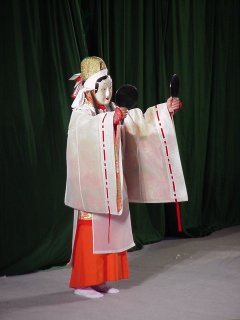 |
stories
Some of the material is familiar from anthologies of Japanese mythology such as the Kojiki.
This is a scene from one of the oldest stories - the actor is dressed as the Amaterasu,
Goddess of light. Taking offense at the shinnegans of another deity,
she has locked herself in a cave, leaving the world in darkness.
The play involves attempts by the other Gods to coax her back.
In one version of the story, a fellow-Goddess creates a
proto-stage by overturning a wash basin. Her bawdy performance creates quite a stir.
When Amaterasu peeps out to see what the fuss is about, the other Gods pull
her from the cave and light is thus restored.
This is likely both an early attempt to understand a solar eclipse,
and an illustration of the belief that song and dance restore balance to life. |
space
The space for Kagura is less permanent than for either Noh or Kabuki.
When performers dance within a shrine complex, they augment the bare open stage
using curtains decorated with the logo of their club. There are no seats for the audience -
people stand and watch for awhile, and then move on.
For day-long competitions, a multi-purpose space is used. I have been to festivals
held in boxing rings, high school gymnasiums, and in shopping malls.
A temporary stage is put at one end of the room, and the first performance of the day
is always a purification rite by a Shinto priest. |
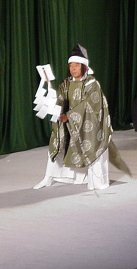 |
Generally, the audience sits wherever they can -
on folding chairs, picnic blankets, or in the bleachers.
In some places, traditional bamboo mats are placed on a dirt floor,
and the area is divided into family-sized squares by a low railing.
People bring blankets, cushions and lunch, making a festive picnic out of the occasion.
This sort of arrangement was once associated with both noh and kabuki performances, but
has been lost. The push for western architecture around the turn of the century dealt the
final blow. In Hiroshima's Astel auditorium for example, there are only two
(basically figurative) bamboo mat areas - all the rest is done in
familiar concert-hall style. |
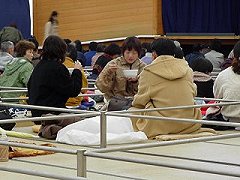 |
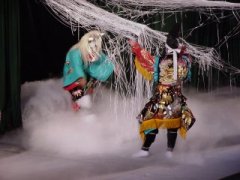
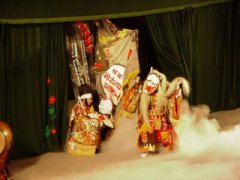 |
props
Clubs bring special effects to their performances
- smoke machines are a hit with the auddience, and are usually associated with
the entrance of a demon.
Paper spider webs are either concealed in the palm of an actor's hand, or are
hidden above the entrance break in the back curtain.
These are dropped or thrown as the demon attempts to ensnare his righteous victim.
Other props include bows and arrows, mirrors, swords and daggers.
Sacred objects such as prayer sticks and bells are also used, depending
on the play. |
more information
There is less in English about Kagura in comparison to other types of Japanese arts.
This is probably related to the diversity of performance styles using this label.
The most complete source in English is by Irit Averbuch: The Gods Come Dancing: A study of the Japanese Ritual
Dance of Yamabushi Kagura, published in the Cornell East Asia Series.
web-links: Zero One of the mountain village of Chiyoda
has put together a bilingual, multimedia CD-ROM, including text,
music files and video - really impressive.
Scholarly links:
U of California Irvine or Hiroshima Women's University
for example. There are also a few government links, such as this one by Miyazaki
prefecture. |
|




